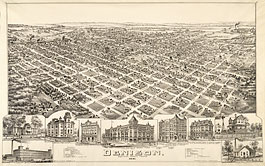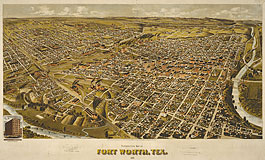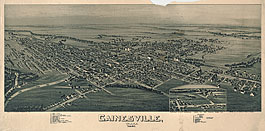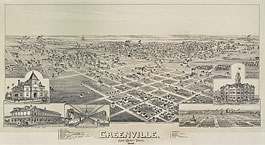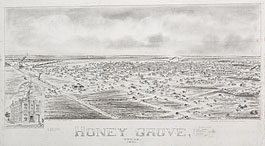Denison in 1891
Thaddeus Fowler perhaps began his second tour of Texas with his picture of Denison, a growing city with a population approaching 11,000 by 1891. On January 11, The Sunday Gazetteer reported that the artist had been in the city for several weeks making pencil sketches for the new bird’s-eye view, which would be much larger than previous views of the city. “It is believed to include every residence within… [More]
Fort Worth in 1891
The fact that Henry Wellge was back in Fort Worth in 1891 to revise his 1886 view demonstrates the concern the city fathers had in promoting the city, as they tried to recover from the difficult economic conditions. Again depicting the city from the northeast, Wellge showed the same basic area as in the 1886 print, suggesting that he might have used the earlier print as a pattern for… [More]
Gainesville in 1891
Gainesville continued to grow in the years between Augustus Koch’s visit in 1883 and Thaddeus Fowler’s in 1891, due partly to the arrival of two additional railroads: the Santa Fe in 1886 and the Gainesville, Henrietta and Western Railway in 1887. Almost 6,600 persons called the city their home by 1890, perhaps double the population of 1883. Unlike some communities that suffered when the trail drives came to an… [More]
Greenville in 1891
For a city that waited longer than most for the railroad, Greenville had become a rail center by the time of Fowler’s visit in 1891. In addition to the Missouri, Kansas and Texas, the East Line and Red River, and the Dallas and Greenville railways, the St. Louis Southwestern arrived in 1887 and the Texas Midland in 1896, five years after Fowler’s view. Hunt County was no longer an… [More]
Honey Grove in 1891
Fowler included Honey Grove in his 1891 tour of North Texas and produced an elaborate drawing of the city, highlighted with blue pencil and wash, but there is no record that it was ever lithographed. Perhaps the economic situation had worsened for Honey Grove merchants and farmers since Henry Wellge’s 1886 visit; or perhaps they believed that Wellge’s handsome lithograph had not paid sufficient dividends and were unwilling to… [More]











